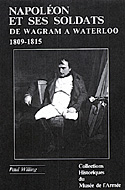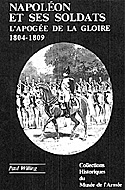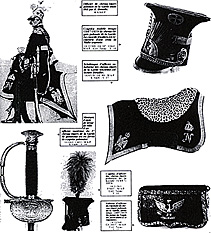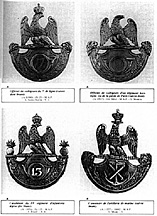 Napoleon et Ses Soldats: L'Apogee de la Gloire 1804-1809, and De Wagram a Waterloo 1809-1815
[Volume 6 and 7 of the series "Les Collections Historiques du Musee de l'Armee"]
Napoleon et Ses Soldats: L'Apogee de la Gloire 1804-1809, and De Wagram a Waterloo 1809-1815
[Volume 6 and 7 of the series "Les Collections Historiques du Musee de l'Armee"]
Author: Colonel Paul Willing, Conservator of the Musee de l'Armee
Pages: 128 each, text is in French
Illustrations:
Vol. 6: More than 500, most pages have 5-7 black and white photographs of articles of equipment, uniforms, or illustrations. Sixteen pages in color with 70 photographs and illustrations.
Vol. 7: Same as volume six, but with 63 color illustrations.
Maps:
Vol. 6: Nine, in the sections that focus on specific campaigns. The maps are a mix, four theater of operations maps covering the campaigns addressed in this volume and five corps or division level maps of the key battles.
Vol. 7: Nineteen, in the sections that focus on specific campaigns. Again, the maps are a mixture of styles and scales, with 10 theater of operations maps covering the campaigns addressed in this volume and nine corps or division level maps of the key battles. Many of the maps are too small to be useful references.
Footnotes: None
Appendices:
Vol. 6: Two, a list of Napoleon's victories from 1805 through 1809 and a list of the painters, engravers, and sculptors mentioned in the captions.
Vol. 7: Three, an order of battle for the Armee du Nord in June, 1815, a list of Napoleon's victories from 1809 through 1815, and a list of the painters, engravers, and sculptors mentioned in the captions.
Bibliography:
Vol. 6: 47 archival and secondary sources noted, including 7 periodicals
Vol. 7: 46 archival and secondary sources noted, including 6 periodicals.
Index: None.
Publisher: Editions Preal, 36, Avenue Jean-Jaures, 94110 ARCUEIL, France
Publication Date: Vol. 6: 1986 Vol. 7: 1987
Binding: Cloth, hardbound, no dust jacket, covers are glossy coated boards
ISBN: Vol. 6: 2-904768-07-6 Vol. 7: 2-904768-11-4
Price: 240 French francs (about $50 U.S.) each

Summary:
These two books are part of a series covering the entire collection of the Musee de l'Armee in France. Volumes 6 and 7 deal with the Empire period and present a pictorial summary of the extensive Napoleonic collection of the Musee de l'Armee at the Invalides in Paris and at the Chateau de l'Emperi. Their value to a non-French speaking reader is the depth in which they illustrate French uniforms of the First Empire. There is very little text and most of that is confined to captions describing the illustrations, so the French text is not a major impediment. Many of the terms used to describe the uniform articles will be familiar to any student of the period.
 A visit to the Napoleonic galleries of the Musee de l'Armee at the Invalides in Paris is an overwhelming experience for anyone interested in the era and especially a uniform buff. The collection is doubtless the most comprehensive in the world. The items on display are astonishing -- a mannequin of a Lieutenant of the 53rd Line wearing the 1805 white uniform (see "Napoleon's White Uniforms", Napoleon # 4, July 1996), one dazzling case full of cuirasses and helmets from both cuirassier and carabinier regiments in pristine condition, a superb uniform of a battalion commander of the Fusilier-Grenadiers of the Young Guard, a uniform coat and shako from the Westphalian 6th Regiment of Line, the model 1804 flag from the 1st Regiment of the Grenadiers a Pied. The list is extensive and all these items are pictured in these two volumes.
A visit to the Napoleonic galleries of the Musee de l'Armee at the Invalides in Paris is an overwhelming experience for anyone interested in the era and especially a uniform buff. The collection is doubtless the most comprehensive in the world. The items on display are astonishing -- a mannequin of a Lieutenant of the 53rd Line wearing the 1805 white uniform (see "Napoleon's White Uniforms", Napoleon # 4, July 1996), one dazzling case full of cuirasses and helmets from both cuirassier and carabinier regiments in pristine condition, a superb uniform of a battalion commander of the Fusilier-Grenadiers of the Young Guard, a uniform coat and shako from the Westphalian 6th Regiment of Line, the model 1804 flag from the 1st Regiment of the Grenadiers a Pied. The list is extensive and all these items are pictured in these two volumes.
Despite the lack of an index, these books make it possible to carry away a thorough, well-organized record of the collection. It is very instructive to compare these photographs of actual uniform items with uniform plates -- and it is much easier to do that at home than to carry an armload of books around the museum!
The first volume focuses on the uniforms of the French during the First Empire. There are chapters on the Emperor, his military household, the Marshals, the Imperial Guard, General Officers, the Infantry, and finally the Artillery and its equipment. Each chapter is about twenty pages long, with typically 5-7 photographs or illustrations per page. Most of the photos are of uniform items or fully clothed mannequins and are in black and white. The color sections interspersed throughout each book have space devoted to significant items in the collection from each of the chapters. In addition to the pictures of uniform items, there are illustrations of important prints, maps, and paintings from the museum's collection.
The last 30 pages of the first volume chronicle the period from 1804 until just before the campaign against the Austrians in 1809. This section is in the same format as the previous uniform and equipment oriented section; with very little text and 5-7 photos or illustrations per page. There are more illustrations of prints and paintings depicting the key events of the period, again with explanatory captions, and only a few uniform and equipment pictures. While most of the paintings and engravings will be familiar to students of the period, the author has grouped them chronologically and by campaign.
Volume seven is in the same format as Volume six, 5-7 black and white illustrations per page and five supplemental color sections. The first four chapters of this volume cover military orders of the First Empire, the Cavalry, the Specialist troops, and finally Foreign Troops in the service of Napoleon. The majority of this volume covers the campaigns from April 1809 through Waterloo, depicted through uniforms, equipment, and artwork. The volume concludes with an epilogue covering artifacts of Napoleon's stay on St. Helena, his death, and the return of his body to France in 1840.
 Each illustration in both volumes has a caption (in French) that identifies the item and typically adds some other background information, such as what years the article was used or some detail concerning a uniform article's original owner. Each caption also indicates which museum has the item and exactly where it can be found. The size of a typical illustration is less than a quarter of a page, but this allowed Colonel Willing to pack an incredible number of photos and illustrations into each volume.
Each illustration in both volumes has a caption (in French) that identifies the item and typically adds some other background information, such as what years the article was used or some detail concerning a uniform article's original owner. Each caption also indicates which museum has the item and exactly where it can be found. The size of a typical illustration is less than a quarter of a page, but this allowed Colonel Willing to pack an incredible number of photos and illustrations into each volume.
These two volumes are a key reference for anyone interested in the uniforms or equipment of the Napoleonic era. Many fine points of French uniforms of the period are depicted in great detail here, such as sword belt buckles, officer's gorgets, shakos, and epaulettes. Volume seven, for example, has a section on grenadier headdress plaques depicting 12 different authorized and un-authorized designs and another section with 18 illustrations of shako plates covering the 1806, 1810 and 1812 designs. Experienced collectors use this set as sourcebooks to help verify the authenticity of an artifact. Sheperd Paine listed them as his most important reference (see "Owning a Piece of the Legend", Napoleon #5, September, 1996).
Several booksellers in the U.S. apparently have problems trying to get books from French publishers, which is why key references like these are hard to locate here. While they may be difficult to find, these two volumes are well worth the effort for any collector or uniformologist. If the opportunity comes up to visit Paris, a stop at the Invalides should rank very high on anyone's list of "must do's" even to only pop into the museum shop to buy these two books.
Back to Table of Contents -- Napoleon #6
© Copyright 1996 by Emperor's Press.
This article appears in MagWeb (Magazine Web) on the Internet World Wide Web.
The full text and graphics from other military history magazines and gaming magazines are available at http://www.magweb.com